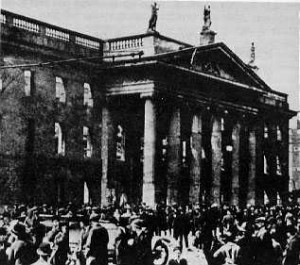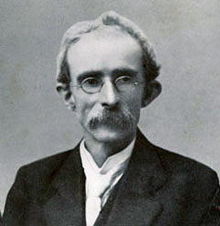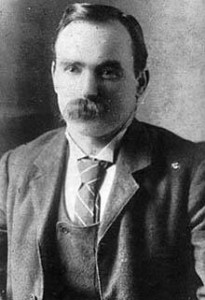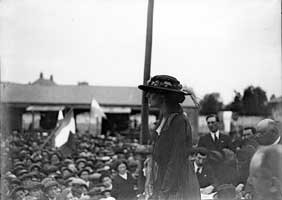Opinion: What kind of future did the Men of 1916 dream of?

By John Dorney
For 100 years now in Ireland, when we are facing some national crossroads, someone will inevitably invoke the ‘men of 1916’. Occasionally nowadays the women get a mention too.
In 2006 at the 90th anniversary it became a truism that the Easter Rising had been vindicated by the Celtic Tiger economic boom. Garret Fitzgerald, (son of 1916 rebel Desmond) argued that without the Rising, Ireland could never have developed its own economic policy – attracting foreign investment with low taxes for example.
After 2008 the mood changed of course, after the financial meltdown of that year when Ireland’s banks all but collapsed and the then government guaranteed their holdings, saddling the country with a huge debt.
At every crossroads in Irish history someone wonders aloud what the ‘the men of 1916’ would have thought.
The Irish Times lamented in 2010 at the time of the IMF Bailout when Ireland lost its financial sovereignty, ‘Was it for this’ they asked that the men of 1916 had died? Tearful contributors to TG4’s excellent series Seachtar na Casca on the executed leaders of 1916, wondered too if they had died for nothing.
More recently at the referendum on same sex marriage, the Easter Rising was invoked by both sides. On the no side, an anonymous leaflet was brought out claiming that the patriot dead would be horrified by a change in the constitution. On the yes side some thought that passing same sex marriage was a fitting tribute to what the insurgents of April 1916 fought for, 100 years on.
So potent is the symbolism of the Easter Rising – selfless bravery, patriotic heroism, martyrdom – that it is used to support almost any vision of what Ireland should be like.
But what kind of Ireland did the leaders of the 1916 Rising actually envisage?
First of all who were they?

One of the extraordinary things about 1916 is that although it was basically the work of two main organisations – the Irish Republican Brotherhood and the Irish Volunteers – the formal leadership of neither organisation even knew about the Rising until it had begun.
It was organised in secret by a ‘Military Council’ set up in 1915, composed of seven men – IRB veterans Tom Clarke and Sean McDermott, James Connolly of the Irish Citizen Army, Patrick Pearse, the educator and cultural nationalists along with fellow Gaels Tomas MacDonagh, Eamon Ceannt, and Ned Daly.
Eoin MacNeill, the leader of the Volunteers, was famously only told of the Rising on Easter Sunday and tried to call it off. Bulmer Hobson, a senior IRB figure was arrested on McDermott’s orders to stop him aiding MacNeill. So even within radical nationalism, the Rising was launched by a secret, self-selecting group.
So what did they believe in?
Independence
It seems like an obvious point, but what united the somewhat diverse views of the 1916 leaders was a belief in Irish independence.
The Rising’s leaders were uncompromising on the need for the full independence of all of Ireland.
This united the cultural nationalists like Patrick Pearse, the socialist James Connolly and veteran IRB men Clarke and MacDiarmada.
Connolly for instance wrote; ‘the principle that the freedom of a people must in the last analysis rest in the hands of that people – that there is no outside force capable of enforcing slavery upon a people really resolved to be free, and valuing freedom more than life.’
Pearse at O’Donovan Rossa’s funeral in 1915 famously declared, ‘Ireland unfree shall never be at peace’. And these sentiments lay at the heart of what launched the Rising of 1916 – the idea that no compromise on Irish independence was possible.
Equally unsurprisingly, though it must now be played down in the official commemorations of 1916, the ‘men of 1916’ were staunchly against the partition, first mooted in 1914.
Irish Freedom the IRB’s newspaper declared in 1914 “North east Ulster is as much part of Ireland as Dublin, Kerry or Clare”.
Economics

Cultural nationalists such as MacDonagh and Ceannt, had in truth little to say on the economic future of Ireland. Patrick Pearse had only the vaguest of formulas.
James Connolly was a Marxist and advocated throughout his life, what he called, ‘the cooperative commonwealth’ that is a democratic socialist transformation. At some points in his career, he argued very strongly for ‘syndicalism’ or what he usually termed ‘industrial democracy’, whereby the workers would take over industries and run them, via their unions, on cooperative lines.
Writing in 1908 for instance;
Under a social democratic form of society the administration of affairs will be in the hands of representatives of the various industries of the nation; that the workers in the shops and factories will organize themselves into unions, each union comprising all the workers at a given industry; … that representatives elected from these various departments of industry will meet and form the industrial administration or national government of the country. James Connolly appears to have envisioned a socialist state along syndicalist lines.
At other times he appeared to argue for the leading role of a political party in a socialist state. And at other times still he appeared to be in favour of reformist socialism or social democracy. To this end he helped to found the Labour Party in 1912.
Though Connolly is perhaps the most fashionable of the 1916 leaders today, the views of the IRB influenced leaders were probably more influential in the founding of the Irish state.
Most separatists in Sinn Fein and the IRB wanted not socialism but to protect and to build up Irish industry.
The IRB had worked with Arthur Griffith’s Sinn Fein from that party’s founding in 1905 up to 1910. And while they broke with Griffith in favour of a more militant line from then on, they absorbed much of his economic thinking. Separatists tended to argue that all of Ireland’s economic ills could be traced back to British domination.
Irish Freedom the IRB’s newspaper for instance opined in 1913 that Ireland capable of easily supporting 20 million people, if domestic Irish industry was not ruined by British competition. Strikes, it argued, were, “the direct result of the British connection”. “Class War”, it argued, was, “incidental to commercial decadence”.“Independent Ireland would of course, have disputes between capital and labour, but they would be fights to re-adjust a balance, not a fight to the death”.
An independent Ireland should, they argued, create and protect its own industries. It should enact radical land reform, not only buying out the remaining big landlords, but also the ‘ranchers’ and returning the land to food production. They also argued in favour of things like reforestation – not so much, as today, for environmental reasons, but to provide work and resources to poor rural areas.
The truth is that many of these theories were tried in independent Ireland after 1922, particularly by the first Fianna Fail governments in the 1930s. Some, for instance historian Conor McCabe argue that they never went far enough, not setting up an Irish Central Bank until the 1940s, not breaking from Sterling until 1980. Bulmer Hobson in his later career as a civil servant vehemently argued in favour of reforestation and a return to tillage farming as revolutionaries had advised in the early 1900s.
Other 1916 rebels though, like Sean Lemass, who were partisans of economic nationalism, argued by the 1950s that they had simply failed and that the future lay in an open economy, attracting foreign companies by low taxation and other incentives; policies that are still the accepted wisdom in Ireland today.
Women’s rights

The Proclamation of the Irish Republic begins ‘ Irishmen and Irish women’ a nod towards women’s equality and their right to vote.
It would be a mistake to think that the rebels of 1916 were ardent feminists. Of the 2,500 people who eventually received pensions for their role in the Rising, only about 230 were women. Even the women’s nationalist movement, Cumann na mBan, though many of them had also been suffrage activists tended to subordinate feminism to separatism.
Maire O Brolchain of Inghinidhe na hEireann, the ancestor of Cumann na mBan, while she acknowledged that some women nationalist were also suffrage activists recalled, ‘The Innghinidhe was unique among women’s organizations in that it took no interest whatever in women’s rights or suffrage, it just did what was most urgent for Ireland.’
Even radical feminists like Helena Molony insisted that national self-determination must come before women’s liberation. She defined herself and her comrades as ‘Irishwomen pledged to fight for the complete separation of Ireland from England and re-establishment of our native culture’.
The 1916 rebels supported women’s suffrage but it is a mistake to think that feminism was a major part of their thinking.
Among the Republican leadership, Connolly was the most active feminist, famously calling women workers ‘the slave of the slave’. Irish Freedom also praised the suffrage activists as ‘fighters for freedom’. On the other hand the separatists’ rivals the Irish Parliamentary Party were generally against women’s right to vote. Its deputy leader John Dillon said once that women’s suffrage threatened the future of civilisation.
So although the rebels of 1916 were towards the progressive end of the scale on women’s rights, it is untrue as some argue today, that the Rising was somehow feminist in ideology. There were feminists who took part, as there were socialists, but it was nationalism that defined the Rising.
Personal Freedom and religion
The Proclamation of the Republic guaranteed religious and civil liberty. The oft-quoted line promising to ‘cherish all the children of the nation equally’ is also, in truth a pledge not discriminate against religious or political minorities. The Proclamation also guaranteed ‘absolute religious liberty’.
The IRB and most other separatists were against sectarianism. The exclusion of Protestants from the all-Catholic Hibernians (who were aligned with the Irish Parliamentary Party) was, for Irish Freedom, “dangerous and insidious”. “Hibernianism had postponed Irish unity for a generation”, and, “Sectarianism is the decay of the genuine nationalist ideal … All sects must stand together”.
The Easter insurgents were neither secular visionaries nor the storm troopers of Rome Rule.
However, unlike for instance the Fenian Proclamation of 1867, the 1916 rebels did not guarantee the separation of Church and state. They were in fact by and large a much more religious generation. During battle in Easter week, many knelt and said the rosary.
The Easter rebels were not the storm troopers of ‘Rome Rule’ as some now like to paint them, but nor were they the secular revolutionaries others now like to imagine.
There was also an element of authoritarianism about the imagined Republic. In 1910 Irish Freedom declared that the true Irish Republican believed in, ‘personal liberty, equality of all men in the eyes of the state and denial of rights unless they are accompanied by an acceptance of duties’. The latter was an interesting phrase. Who would decide what the duties of an Irish citizen were?
No doubt in the mind of the IRB and the 1916 insurgents generally, it was them, the Republican revolutionaries.
The IRB and all of the most radical nationalist organisations supported universal suffrage as a demand, but they also regarded themselves as an elite vanguard who may have to push the passive majority in the right directions – ‘’He is called to a brave charge who is called to resist the majority, but resist he will knowing that he will lead them to a dearer dream than they have ever known.’
A contradictory legacy
Included in the veterans of the Rising were men who in 1923 gave all women over 21 the right to vote, but also those men who in 1927 excluded women from jury duty.
Some of the Rising’s veterans like the actor Arthur Shields bemoaned the culture of censorship in independent Ireland, but others like Abbey Director Ernest Blythe were enthusiastic censors.
Roddy Connolly, James’ son, went on to found the Communist Party of Ireland, while other Rising veterans, for example Eamon de Valera and Richard Mulcahy are associated today with an era of cultural and social conservatism.
History can teach us lessons. But it is a guidebook, not a blueprint.